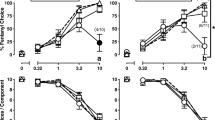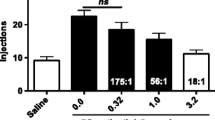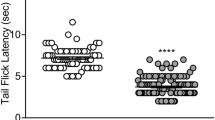Abstract
Rationale: Associative tolerance to the analgesic effects of morphine is most pronounced when morphine is paired with a distinctive context at a long inter-dose interval (IDI). In contrast, morphine administered at a short IDI promotes the development of non-associative tolerance and disrupts the acquisition of associative tolerance. The impact of IDI on the development of associative tolerance to opioids other than morphine has not been investigated previously. Objectives: This research examined associative and non-associative tolerance to the analgesic effects of fentanyl in rats. Cross tolerance for these two forms of tolerance with morphine (mu- receptor agonist) and U50,488H (kappa-receptor agonist) analgesia was also investigated. Methods: Animals were given eight fentanyl injections (0.10 mg/kg) paired or unpaired with a distinctive context at either a 3-h (short) or 96-h (long) IDI. Subjects were then tested for tolerance in the distinctive context using the tail-flick procedure and dose–response curve methodology. Results: At the short IDI, animals developed non-associative tolerance to fentanyl that was receptor specific, i.e., cross tolerant with morphine analgesia but not with U50,488H analgesia. At the long IDI, fentanyl-tested animals displayed tolerance that appeared to be controlled primarily by associative processes. This associative form of tolerance was also receptor specific, displaying cross tolerance with morphine but not with U50,488H. Conclusions: The impact of IDI on the development of non- associative and associative fentanyl tolerance is consistent with findings obtained with morphine showing that conditions conducive to the development of non-associative tolerance disrupt the acquisition of associative tolerance. The cross-tolerance data, however, did not parallel previous research examining the cross-tolerance profiles of associative and non-associative morphine tolerance.
Similar content being viewed by others
Author information
Authors and Affiliations
Additional information
Received: 26 April 1999 / Final version: 5 October 1999
Rights and permissions
About this article
Cite this article
Carter, B., Tiffany, S. & Conklin, C. Associative and non-associative fentanyl tolerance in the rat: evaluation of cross tolerance with mu-and kappa-specific opioids. Psychopharmacology 148, 384–392 (2000). https://doi.org/10.1007/s002130050067
Issue Date:
DOI: https://doi.org/10.1007/s002130050067




